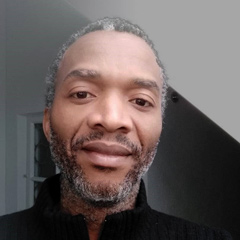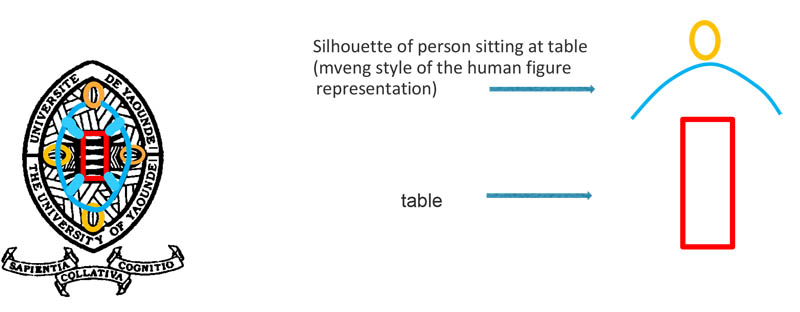
Paul-Henri Souvenir ASSAKO ASSAKO
The logo takes on the formal look of the chips used in the “Abbia” game. It is a traditional game that was played only by men in the South Cameroon Plateau until the beginning of the colonial period. In its general form, the logo is comprised of two main parts: an upper part which bears the phrase “The University of Yaoundé 1” (in French and in English) and a lower part that is defined by the slogan in Latin words “sapientia collativa cognitio” (wisdom is collected cognition).
The central part of the upper component of the logo features four human figures organized around a table. The rigid geometrization of the composition of the logo and the regularity of the lines give great expressiveness to these graphics. The treatment of the shape of the logo exhibits remarkable influence by traits of the “Abbia” token. The geometric schematization of the pattern and the ogival shape of the logo scrupulously drawn by regular lines determine the elements that mark this influence.

The name of the game “Abbia” refers to “hazard”, “a game of chance where bets are placed, which may be a simple gourd of palm wine, a human being (woman or child), livestock, or the player's farm or plantation etc.” (Cyrille Bela, 2006). These are not just simple tokens but a characteristic artistic expression that is pertinent to the sculptural heritage of South Cameroon’s population. These tokens obtained from the pits of the sapotaceous fruit (Mimusops le-testui), present on their smooth faces a wide variety of anthropomorphic, zoomorphic, geometric subjects, etc. minutely engraved in bas-relief by the artists. In addition to their use for the game, Abbia tokens are also ideograms and pictograms that have sometimes been associated with divinatory practices (Maurice Pervès, 1949: 27). Designing a logo that is inspired by them is significant from a dual aesthetic and symbolic perspective capable of inspiring elements of content to national identity.
On the independence trajectory of the 1950 – 1960 period, the year 1957 is significant. It is marked by the creation of Cameroonian citizenship and the adoption of the first symbolic acts of the nation. After the investiture of André Marie Mbida, the first Prime Minister of the State of Cameroon on May 15th, 1957, the Legislative Assembly of Cameroon (ALCAM), on November 10 of the same year, chose the first national emblems: national anthem, flag, and a motto. From that moment, the visual and artistic elements revealed themselves and displayed their importance very early in the narrative of the history of the Cameroonian nation and the constitution of its heritage. The adoption of these national identification symbols is not unequivocal. We note with regret the anonymity of the authors/creators of these national emblems: “but we must nevertheless state the fact that no specific and nominal mention was made of the Cameroonian authors of the national anthem thus chosen. Later in 1960, the same silence will be reserved for the author – also Cameroonian, of the seals of the Republic of Cameroon, without us fully understanding the meaning to be given to these oversights” (J. E. Pondi, 2012: 65).
The trauma created by the sanctions imposed by the colonial powers on the various forms of reference to local iconographic and symbolic culture could justify the timidity of an exaltation of visual culture and its authors. The elements of visual and symbolic language such as the logo will come from an experience of distant memory and sporadic circumstances for several years. We observe, for example, that for several years the University of Yaoundé remained without a logo. The covers of the University’s annals of 1969 and 1970 illustrate this and bear only the words “Federal University of Yaoundé”. During the same period within the intellectual elite of the aftermath of independence, a nostalgia for traditional artistic culture is expressed in a literary modality. For example, one of the most important cultural journals created by this elite in 1962 is called Abbia in reference to the art of “Abbia”.
The absence of details on the date of creation and the conditions for the adoption of the logo of the University of Yaoundé does not exclude the probability that it was designed and produced by Engelbert Mveng between 1983 and 1987. Everything suggests that Mveng's legitimacy to take credit for the creation of this logo has not been subject to any reservations. As a Jesuit priest and artist/researcher, Engelbert Mveng’s cultural sensitivity, his academic reputation and his important artistic promotion action must have facilitated the adoption of the logo by the University’s administration. (Engelbert Mveng was Director of Cultural Affairs at the Ministry of Education and Culture from 1966 to 1974. Then, from 1983 to 1987, he was Head of the History Department at the University of Yaoundé.)The 1993 University Reform with the establishment of new state universities in Cameroon was also a significant factor in the creation of this logo. In Yaoundé, for example, the presence of two universities undoubtedly required the elements of visual identity capable of distinguishing the University institution from the others.
Universities are considered by politicians as the contexts for the conception of modern culture with identity characteristics for the young nation. Mveng (1930-1995) does not lose sight of this perspective. This is how he undertakes the re-appropriation and integration of traditional knowledge and skills in the creative process of the logo. The author applies his theory of the “loi de creation esthétique” (aesthetic process of creation) to the graphic design of the University of Yaounde’s logo.
The simplified form of this process is “OLMC” where O represents “natural object”, L represents “essential line of the object”, M is for “motif”, and C represents “composition”. This process was inspired by a methodological scheme of synthesis that Mveng (1980) notes by studying traditional artistic practice in several African societies. Mveng observes a recurrence of certain principles of creation: the observation of the natural object, the graphic representation of the object limited to the essential line and finally the use of the essential line as motif / sign in the composition of the works of art. The practical applications of this process favoured the development of an iconographic style and a production of works with a characteristic and very singular visual identity. This style is characterized by a schematic reinterpretation of the elements that surround us in patterns that we arrange in the compositions, which we transpose on different supports. In 1966, Mveng, inspired by the idea of modernizing “traditional African art”, created the “Art Nègre” workshop in Yaoundé. This workshop became a veritable laboratory for graphic design of iconography called to mark a cultural renewal.
Thanks to the privileged social and political position held by Mveng (priest, academic and artist), the Negro Arts Workshop succeeded in producing several works (paintings, drawings, sculptures, collages, etc.) both in Cameroon and in the diaspora. The workshop brings together artisans from various regions of Cameroon. It created a form of co-incorporation and also developed an important part of the production of religious art there. On the same methodological principles of “aesthetic creation”, the workshop produced the first liturgical imagery which presents the characteristics of the phenomenon of inculturation in the Cameroonian Catholic Church.
The University which the logo identifies is an educational context that predicts the future of society. The development of this society depends on the quality of training/education, skills and values that the school gives to young people. Education extends to everything from economic expansion to civic spirit. It engages the individual and collective prosperity of the country recalled in 1965 by Ahmadou Ahidjo (first president of the Cameroonian republic). The motto of the University in Latin: “sapientia collativa cognitio” displays the ideas that are dear to this institution whose mission is to train each Cameroonian well, to make him an artisan of prosperity and to make him a participant in the management of the state (J. C. Bahoken and E. Atangana, 1975).
The mention in French and English of “Université de Yaoundé 1/University of Yaoundé 1”, which follows the contours of the upper component of the logo, mainly reflects the bilingual nature of the Cameroonian University. Of course, this bilingualism is one of the symbolic markers of the political and cultural history of the unity of Cameroon. It expresses national political unity and guarantees openness to the participation of the Cameroonian University in transnational and intercultural dialogue that is essential for the development of the country. To use President Ahmadou Ahidjo's words during the inauguration of the said University on November 17, 1967, the University is an instrument of “dialogue with all nations of good will”.
Nowadays, the vices which characterize Cameroonian society such as corruption, the weakening of the patriotic and nationalist spirit in favour of ethnic and regional withdrawals, the weakening of the civic spirit, the inadequacy between training and employment and unemployment, to cite only these examples, expose the weaknesses of the education system in the country. The factors responsible for such an assessment are inter alia linked to the problems of immaturity of educational references very often adopted in a circumstantial manner (at random). Learning suffers from a lack of ingenious practices linked to the social transformation project. In other words, the educational project has a hard time building learning methods that take into account the socio-cultural, political and economic flows and bridges now established between here and elsewhere, today and tomorrow. As George E. Hein (2011) wrote, understanding learning as a social activity is a principle for considering successful education. An educational project which does not take this into account would venture to commit the fate of society at random as in the scenario of the game of “Abbia” where the most important goods of the players were randomly bet.
Download Paul-Henri Assako Assako's presentation on the origin of the logo by following this link.
References
- BAHOKEN J.C. et ATANGANA Engelbert. 1975. La politique culturelle en République unie du Cameroun, Éditions Les Presses de l’Unesco.
- BELA Cyrille. 2006. l’art des abbia : une forme d’expression sculpturale des pays pahouin, in « Afrique : archéologie et arts », 4 | 2006, p. 83-90.
- George E. HEIN. 2011. Constructivist learning theory//1991, in education, documents of contemporary art, London, Edited by Felicity Allen.
- MVENG Engelbert.1980. L’Art et l’Artisanat Africains, Éditions CLE, Yaoundé.
- PERVÈS Maurice. 1949. Parmi les Fangs de la Forêt Equatoriale : le jeu de l’Abbia, Revue de géographie humaine et d’ethnologie n° 3, p. 26-41.
- PONDI Jean-Emmanuel, 2012, (Re)découvrir Yaoundé ! Une fresque historique et diplomatique de la capitale camerounaise, Yaound Ed. Afric’Eveil.
- https://journals.openedition.org/aaa/1373.
- https://www.osidimbea.cm/cameroun-okoba/cameroun-1967/
published February 2020


